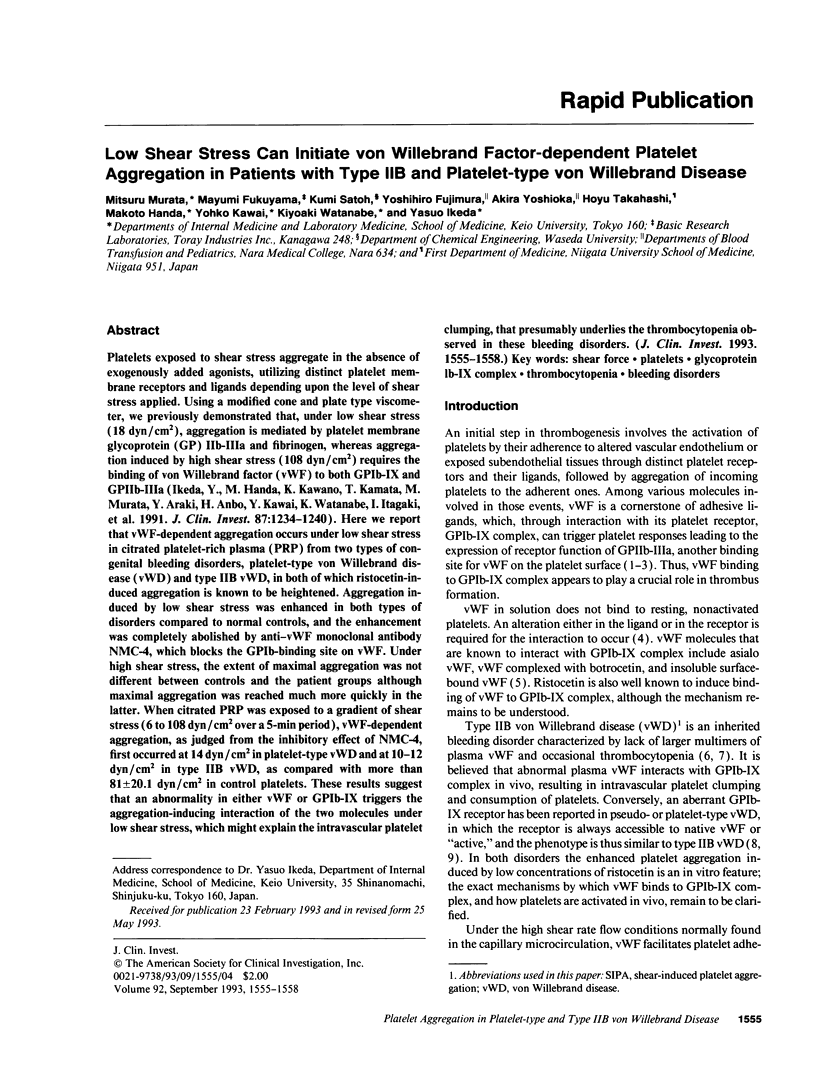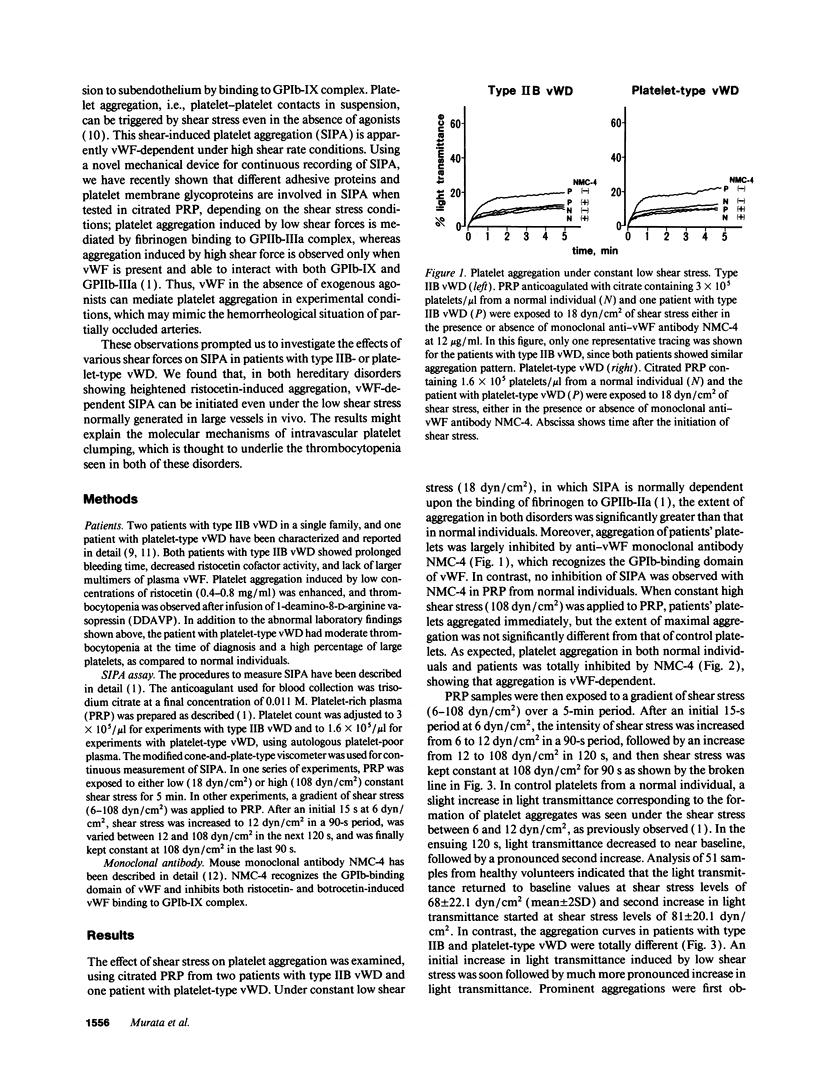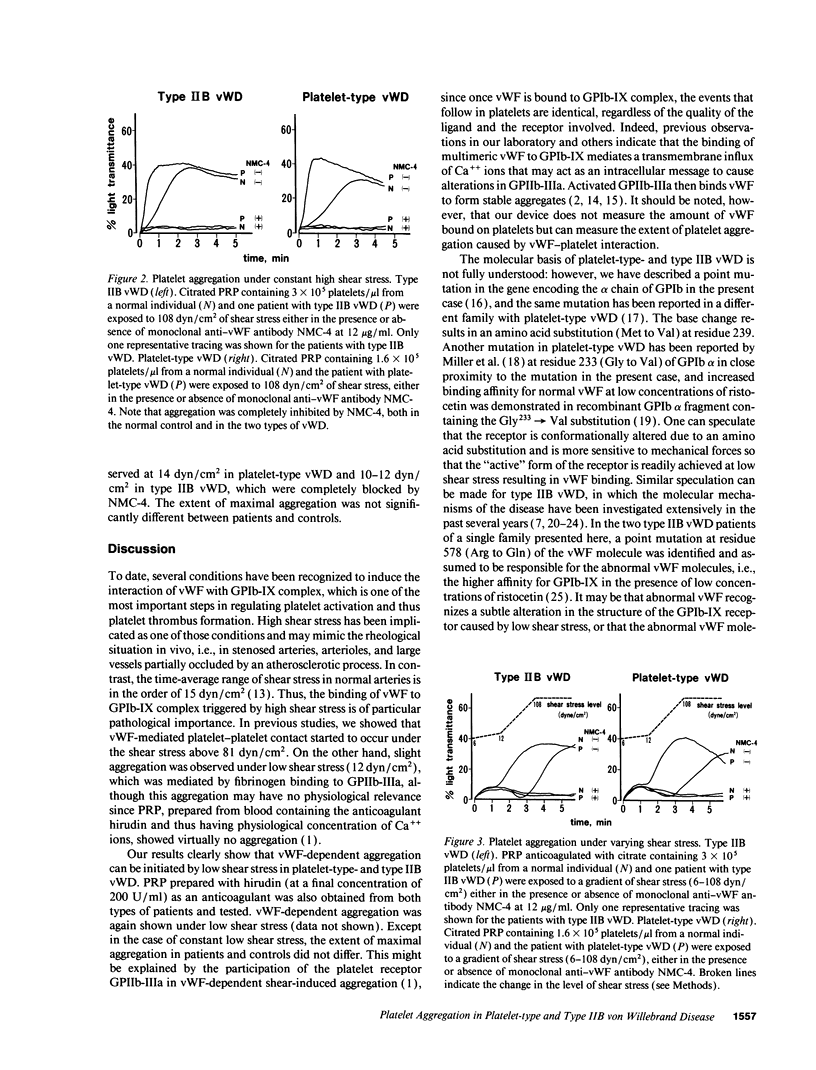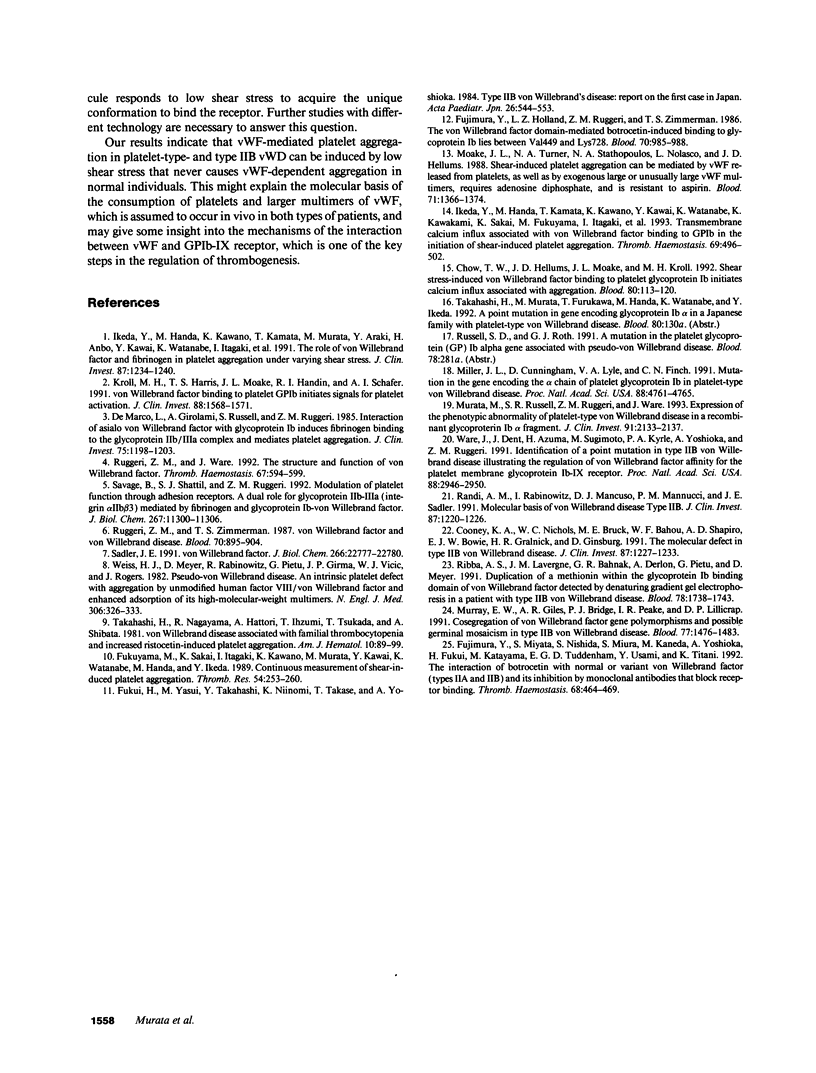Abstract
Platelets exposed to shear stress aggregate in the absence of exogenously added agonists, utilizing distinct platelet membrane receptors and ligands depending upon the level of shear stress applied. Using a modified cone and plate type viscometer, we previously demonstrated that, under low shear stress (18 dyn/cm2), aggregation is mediated by platelet membrane glycoprotein (GP) IIb-IIIa and fibrinogen, whereas aggregation induced by high shear stress (108 dyn/cm2) requires the binding of von Willebrand factor (vWF) to both GPIb-IX and GPIIb-IIIa (Ikeda, Y., M. Handa, K. Kawano, T. Kamata, M. Murata, Y. Araki, H. Anbo, Y. Kawai, K. Watanabe, I. Itagaki, et al. 1991. J. Clin. Invest. 87:1234-1240). Here we report that vWF-dependent aggregation occurs under low shear stress in citrated platelet-rich plasma (PRP) from two types of congenital bleeding disorders, platelet-type von Willebrand disease (vWD) and type IIB vWD, in both of which ristocetin-induced aggregation is known to be heightened. Aggregation induced by low shear stress was enhanced in both types of disorders compared to normal controls, and the enhancement was completely abolished by anti-vWF monoclonal antibody NMC-4, which blocks the GPIb-binding site on vWF. Under high shear stress, the extent of maximal aggregation was not different between controls and the patient groups although maximal aggregation was reached much more quickly in the latter. When citrated PRP was exposed to a gradient of shear stress (6 to 108 dyn/cm2 over a 5-min period), vWF-dependent aggregation, as judged from the inhibitory effect of NMC-4, first occurred at 14 dyn/cm2 in platelet-type vWD and at 10-12 dyn/cm2 in type IIB vWD, as compared with more than 81 +/- 20.1 dyn/cm2 in control platelets. These results suggest that an abnormality in either vWF or GPIb-IX triggers the aggregation-inducing interaction of the two molecules under low shear stress, which might explain the intravascular platelet clumping, that presumably underlies the thrombocytopenia observed in these bleeding disorders.
Full text
PDF



Selected References
These references are in PubMed. This may not be the complete list of references from this article.
- Chow T. W., Hellums J. D., Moake J. L., Kroll M. H. Shear stress-induced von Willebrand factor binding to platelet glycoprotein Ib initiates calcium influx associated with aggregation. Blood. 1992 Jul 1;80(1):113–120. [PubMed] [Google Scholar]
- Cooney K. A., Nichols W. C., Bruck M. E., Bahou W. F., Shapiro A. D., Bowie E. J., Gralnick H. R., Ginsburg D. The molecular defect in type IIB von Willebrand disease. Identification of four potential missense mutations within the putative GpIb binding domain. J Clin Invest. 1991 Apr;87(4):1227–1233. doi: 10.1172/JCI115123. [DOI] [PMC free article] [PubMed] [Google Scholar]
- De Marco L., Girolami A., Russell S., Ruggeri Z. M. Interaction of asialo von Willebrand factor with glycoprotein Ib induces fibrinogen binding to the glycoprotein IIb/IIIa complex and mediates platelet aggregation. J Clin Invest. 1985 Apr;75(4):1198–1203. doi: 10.1172/JCI111816. [DOI] [PMC free article] [PubMed] [Google Scholar]
- Fujimura Y., Holland L. Z., Ruggeri Z. M., Zimmerman T. S. The von willebrand factor domain-mediating botrocetin-induced binding to glycoprotein IB lies between Val449 and Lys728. Blood. 1987 Oct;70(4):985–988. [PubMed] [Google Scholar]
- Fujimura Y., Miyata S., Nishida S., Miura S., Kaneda M., Yoshioka A., Fukui H., Katayama M., Tuddenham E. G., Usami Y. The interaction of botrocetin with normal or variant von Willebrand factor (types IIA and IIB) and its inhibition by monoclonal antibodies that block receptor binding. Thromb Haemost. 1992 Oct 5;68(4):464–469. [PubMed] [Google Scholar]
- Fukuyama M., Sakai K., Itagaki I., Kawano K., Murata M., Kawai Y., Watanabe K., Handa M., Ikeda Y. Continuous measurement of shear-induced platelet aggregation. Thromb Res. 1989 May 1;54(3):253–260. doi: 10.1016/0049-3848(89)90233-8. [DOI] [PubMed] [Google Scholar]
- Ikeda Y., Handa M., Kamata T., Kawano K., Kawai Y., Watanabe K., Kawakami K., Sakai K., Fukuyama M., Itagaki I. Transmembrane calcium influx associated with von Willebrand factor binding to GP Ib in the initiation of shear-induced platelet aggregation. Thromb Haemost. 1993 May 3;69(5):496–502. [PubMed] [Google Scholar]
- Ikeda Y., Handa M., Kawano K., Kamata T., Murata M., Araki Y., Anbo H., Kawai Y., Watanabe K., Itagaki I. The role of von Willebrand factor and fibrinogen in platelet aggregation under varying shear stress. J Clin Invest. 1991 Apr;87(4):1234–1240. doi: 10.1172/JCI115124. [DOI] [PMC free article] [PubMed] [Google Scholar]
- Kroll M. H., Harris T. S., Moake J. L., Handin R. I., Schafer A. I. von Willebrand factor binding to platelet GpIb initiates signals for platelet activation. J Clin Invest. 1991 Nov;88(5):1568–1573. doi: 10.1172/JCI115468. [DOI] [PMC free article] [PubMed] [Google Scholar]
- Miller J. L., Cunningham D., Lyle V. A., Finch C. N. Mutation in the gene encoding the alpha chain of platelet glycoprotein Ib in platelet-type von Willebrand disease. Proc Natl Acad Sci U S A. 1991 Jun 1;88(11):4761–4765. doi: 10.1073/pnas.88.11.4761. [DOI] [PMC free article] [PubMed] [Google Scholar]
- Moake J. L., Turner N. A., Stathopoulos N. A., Nolasco L., Hellums J. D. Shear-induced platelet aggregation can be mediated by vWF released from platelets, as well as by exogenous large or unusually large vWF multimers, requires adenosine diphosphate, and is resistant to aspirin. Blood. 1988 May;71(5):1366–1374. [PubMed] [Google Scholar]
- Murata M., Russell S. R., Ruggeri Z. M., Ware J. Expression of the phenotypic abnormality of platelet-type von Willebrand disease in a recombinant glycoprotein Ib alpha fragment. J Clin Invest. 1993 May;91(5):2133–2137. doi: 10.1172/JCI116438. [DOI] [PMC free article] [PubMed] [Google Scholar]
- Murray E. W., Giles A. R., Bridge P. J., Peake I. R., Lillicrap D. P. Cosegregation of von Willebrand factor gene polymorphisms and possible germinal mosaicism in type IIB von Willebrand disease. Blood. 1991 Apr 1;77(7):1476–1483. [PubMed] [Google Scholar]
- Randi A. M., Rabinowitz I., Mancuso D. J., Mannucci P. M., Sadler J. E. Molecular basis of von Willebrand disease type IIB. Candidate mutations cluster in one disulfide loop between proposed platelet glycoprotein Ib binding sequences. J Clin Invest. 1991 Apr;87(4):1220–1226. doi: 10.1172/JCI115122. [DOI] [PMC free article] [PubMed] [Google Scholar]
- Ribba A. S., Lavergne J. M., Bahnak B. R., Derlon A., Piétu G., Meyer D. Duplication of a methionine within the glycoprotein Ib binding domain of von Willebrand factor detected by denaturing gradient gel electrophoresis in a patient with type IIB von Willebrand disease. Blood. 1991 Oct 1;78(7):1738–1743. [PubMed] [Google Scholar]
- Ruggeri Z. M., Ware J. The structure and function of von Willebrand factor. Thromb Haemost. 1992 Jun 1;67(6):594–599. [PubMed] [Google Scholar]
- Ruggeri Z. M., Zimmerman T. S. von Willebrand factor and von Willebrand disease. Blood. 1987 Oct;70(4):895–904. [PubMed] [Google Scholar]
- Sadler J. E. von Willebrand factor. J Biol Chem. 1991 Dec 5;266(34):22777–22780. [PubMed] [Google Scholar]
- Savage B., Shattil S. J., Ruggeri Z. M. Modulation of platelet function through adhesion receptors. A dual role for glycoprotein IIb-IIIa (integrin alpha IIb beta 3) mediated by fibrinogen and glycoprotein Ib-von Willebrand factor. J Biol Chem. 1992 Jun 5;267(16):11300–11306. [PubMed] [Google Scholar]
- Takahashi H., Nagayama R., Hattori A., Ihzumi T., Tsukada T., Shibata A. Von Willebrand disease associated with familial thrombocytopenia and increased ristocetin-induced platelet aggregation. Am J Hematol. 1981;10(1):89–99. doi: 10.1002/ajh.2830100113. [DOI] [PubMed] [Google Scholar]
- Ware J., Dent J. A., Azuma H., Sugimoto M., Kyrle P. A., Yoshioka A., Ruggeri Z. M. Identification of a point mutation in type IIB von Willebrand disease illustrating the regulation of von Willebrand factor affinity for the platelet membrane glycoprotein Ib-IX receptor. Proc Natl Acad Sci U S A. 1991 Apr 1;88(7):2946–2950. doi: 10.1073/pnas.88.7.2946. [DOI] [PMC free article] [PubMed] [Google Scholar]
- Weiss H. J., Meyer D., Rabinowitz R., Pietu G., Girma J. P., Vicic W. J., Rogers J. Pseudo-von Willebrand's disease. An intrinsic platelet defect with aggregation by unmodified human factor VIII/von Willebrand factor and enhanced adsorption of its high-molecular-weight multimers. N Engl J Med. 1982 Feb 11;306(6):326–333. doi: 10.1056/NEJM198202113060603. [DOI] [PubMed] [Google Scholar]


